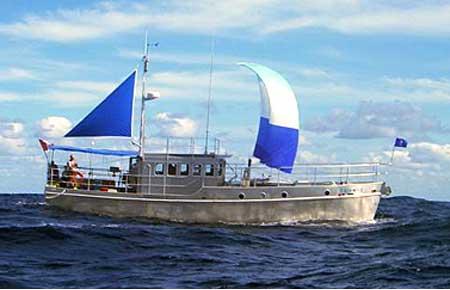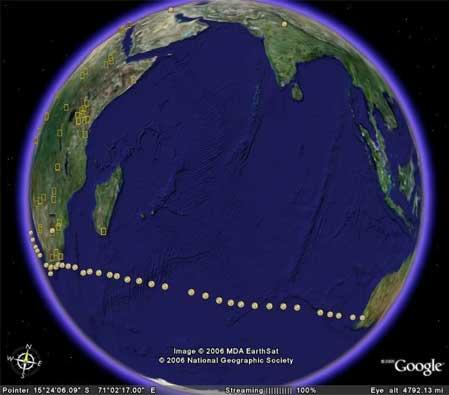 |
||
|
||
© 1997-2017 Water World Productions, formerly Trawler World Productions. All rights reserved. Reproduction of material from any trawlersandtrawlering.com page without written permission is strictly prohibited. Any copyrighted images remain the property of the copyright owner and are believed to be used with permission. Unsolicited letters, e-mails, articles and other materials submitted to us may be published, distributed and stored by Water World Productions and its assignees in whole or in part, in print or by any other means, including but not limited to electronic, and may be edited for clarity and space. Trawlers & Trawlering and its abbreviation T&T, I'd Rather Be Trawlering, Passagemaking Under Power and its abbreviation PUP, Trawler Buy-Sell-Trade, Trawler News, Circumnavigator, and Power Catamaran World are trademarks of Water World Productions.
|
||
Idlewild steams nonstop for 4,495 miles
South Africa to Australia in just under 30 days—sipping 1.39 gallons per hour
Idlewild was equipped with a sailing rig but it was never used during the longest nonstop passage ever by a trawler yacht.
The longest nonstop passage by a trawler yacht has been completed by Idlewild, the shallow-draft 57-footer that was the first trawler yacht to transit the treacherous Northwest Passage across North America. Idlewild ran from East London, South Africa, to Fremantle, Australia, in just under 30 days at sea, arriving at her destination February 12, 2006.
Captain and owner Ben Gray, 66, a retired bison rancher from Alberta, had his two sons, Brad, 38, and Kevin, 35, for crew aboard the George Buehler custom design. Here is the skipper’s summary of the long passage:
“A total of 4,495 nautical miles at 6.4 knots and 5.27 lph (1.39 US gph) and 1.21 mpl (4.57 US mpg) from East London, South Africa, to Fremantle, Australia. We had expected burning 5 liters per hour for 6.25 knots and were prepared to reduce RPM for better fuel mileage for much of the run if necessary. We normally carry 3,800 liters of fuel. Here we carried 1,400 liters extra but only used 3,700 liters so have 1,500 liters left on our arrival in Fremantle.”
Idlewild is powered by a 55-horsepower Kubota diesel engine. The aluminum yacht was built by Reyse Marine in Surrey, British Columbia. She draws only 3 feet 6 inches, shallow for an ocean-going trawler yacht.
Click here for photos and a description of the vessel on the designer’s site.
The shallow draft was necessitated by the fact that Idlewild started her voyage inland, near Grand Prairie, Alberta—2,100 nautical miles from the ocean.
Departing on May 24, 2005, Idlewild followed the Peace River system—where twice the 15-ton boat had to be portaged—to Great Slave Lake and then rode the Mackenzie River to the Beaufort Sea and Arctic Ocean. Idlewild then made a transit of the Northwest Passage and proceeded south down the Atlantic to South Africa.
After touring Australia with family members from Canada for most of February, Idlewild departed Fremantle for Broome and then Darwin.
“We have gone 20,310 nm (23,356 sm, 37,370 km) since leaving Dunvegan, Alberta, on May 24, 2005. We hope to be home before the first snow fall, maybe even before the leaves are all gone this fall,” Ben Gray wrote from Fremantle.
“We have work to do on the boat, then 2000 miles to Darwin and plan to leave Darwin On April 5 for Indonesia, Palau, Guam, and Islands north to Tokyo. June 5 leave Tokyo for Attu and cross our trail near the Diomedes.”
The Diomedes are islands in the Bering Sea where Idlewild will cross her outbound track and thus, officially, complete her circumnavigation of the globe. If he is successful, Gray will be the first to circumnavigate world—under sail or power—starting inland and using portages!

Thanks to Google Earth, it’s now possible to easily track yachts crossing oceans. Idlewild’s record-setting passage across the Indian Ocean is shown above. Image by Chris Byer.
Paravanes added to stop severe rolling
Idlewild’s narrow beam—10 feet at the waterline—translates into excellent efficiency and phenomenal range. Her shallow draft—3 feet 6 inches—permits portaging and river navigation, and makes her safer in ice. Together, the beam and draft combine to generate rolling that can only be described as wicked.
Ben Gray reported from Australia that Idlewild regularly rolled 20 to 40 degrees, sometime hitting 60 degrees and more. Thus, during the hiatus Down Under, paravanes will be fitted to the aluminum yacht.
“It took us 29 days to make it from South Africa to Australia,” Gray told the Edmonton (Alberta) Journal. “Because of the rolling, we were only able to cook on 18 of those days.”
Food was eaten cold, often right out of the can.
The long passage was rough at times, but almost always enjoyed by the adventurous Albertans, as witnessed by a journal entry during the final approach to Australia when the weather turned nasty:
“Wind is still at 30 knots but seas are not as bad as they could,” Gray wrote. “We haven’t seen a ship for almost 3,500 nm. This is a lovely, lonely, lively ocean.”
Site see:
http://www.idlewildexpedition.ca
http://tinyurl.com/ksnhg
http://tinyurl.com/ovdt7